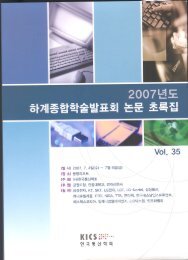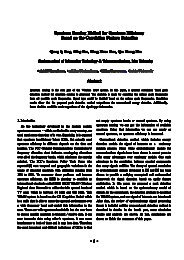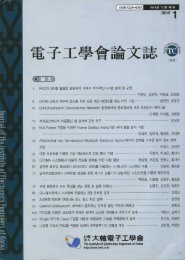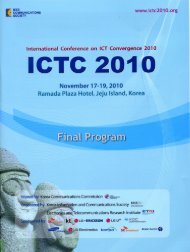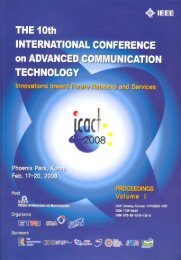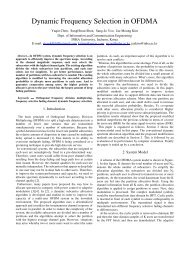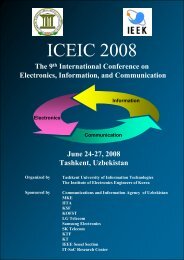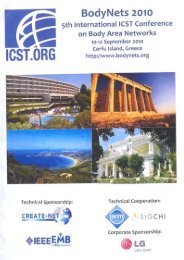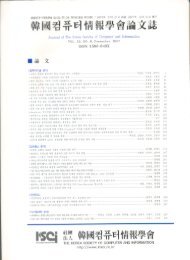Untitled
Untitled
Untitled
Create successful ePaper yourself
Turn your PDF publications into a flip-book with our unique Google optimized e-Paper software.
Frequency Domain Equalization for Doubly Selective Channels<br />
YuQin Chen JongYoung Han Jae Moung Kim<br />
river4416@sina.com, fanaticey@hotmail.com, jaekim@inha.ac.kr<br />
Graduate school of Information Technology & Telecommunications Inha University<br />
Abstract- In this paper, a kind of conventional linear frequency-domain equalizer for doubly selective (time-and<br />
frequency-selective) channels is proposed. We use a basis expansion model (BEM) to approximate the doubly selective channels.<br />
The time-varying impulse response of rapidly fading mobile communication channels is expanded over a basis of complex<br />
exponentials that arise due to Doppler effects encountered with multipath propagation. This model allows us to turn a complicated<br />
equalization problem into a simpler one, containing only the BEM coefficients of the doubly selective channels and the frequency<br />
domain equalizer. Both Zero-Forcing (ZF) and Minimum Mean Square Error (MMSE) equalization are considered.<br />
I. INTRODUCTION<br />
Orthogonal frequency division multiplexing (OFDM) is an<br />
attractive technique for high-speed data transmission in mobile<br />
communications, since it can avoid intersymbol interference (ISI).<br />
The Doppler effect caused by time-variation in conjunction with<br />
ISI give rise to a so-called doubly selective (frequency- and<br />
time-selective) channel. In a doubly selective channel, the channel<br />
variation over an OFDM block destroys the orthogonality between<br />
the subcarriers resulting into so-called inter-carrier interference<br />
(ICI)[1]. In order to mitigate ICI, many techniques, e.g.,<br />
time-domain windowing combined with iterative MMSE<br />
estimation, ICI self-cancellation, have been proposed[2][3]. These<br />
approaches require a high computational complexity or at a price<br />
of sacrificing the spectral efficiency. Moreover, these works<br />
assume perfect knowledge of the TV channel at the receiver,<br />
which is rather difficult if not impossible to obtain.<br />
In this paper, a kind of frequency domain equalization technique<br />
which can compensate for the effects of channel variation in a<br />
multipath fading channel is described by approximating that the<br />
channel impulse response (CIR) is expanded over a basis of<br />
complex exponentials that arise due to Doppler effects<br />
encountered with multipath propagation. This allows us to turn a<br />
large time-variant (TV) problem into an equivalent small<br />
time-invariant (TIV) problem, containing only the BEM<br />
coefficients of the doubly selective fading channel[4].<br />
II.FADING CHANNELS: RANDOM MODLES<br />
In some communication schemes, unpredictable changes in the<br />
medium warrant modeling the TV impulse response (TVIR)<br />
h c(t;τ )as a stochastic process in the time variable t. Since the<br />
components of the multipath signal arise from a large number of<br />
reflections and scattering from rough or granular surfaces, then by<br />
virtue of the central limit theorem, the TVIR can be modeled as a<br />
complex Gaussian process. A simple way to model the fading<br />
channel is wide-sense stationary uncorrelated scattering (WSSUS).<br />
It assumes the channel to be wide sense stationary for a fixed lag<br />
τ and uncorrelated for different lags. The channel spectral density<br />
for a fixed τ is called the scattering function S(ω ;τ );and it<br />
provides a single measure of the average power output of the<br />
channel as a function of the delayτ and the Doppler frequency<br />
ω . The delay-power profile, sometimes also called as multipath<br />
intensity profile, which is defined as the integral ,<br />
∫ ∞<br />
−∞<br />
p ( τ ) = S(<br />
τ , w)<br />
dw<br />
(1)<br />
represents the average received power as function of delay τ ,and<br />
the length of its support is called the multipath spread and is a<br />
measure of the average extent of the multipath. Another function<br />
called Doppler power spectrum<br />
∫ ∞<br />
−∞<br />
S ( w)<br />
= S(<br />
τ , w)<br />
dτ<br />
(2)<br />
is derived from the scattering function and its extent, the Doppler<br />
spread, is a measure of the channel’s time variation[2][5].<br />
s(l)<br />
( )<br />
f tr<br />
c<br />
( l)<br />
sc(t )<br />
(<br />
f ch<br />
c<br />
)<br />
( t;<br />
τ)<br />
vc(t )<br />
rc (l)<br />
f (l)<br />
rec<br />
c<br />
xc (t)<br />
nTs<br />
Fig. 1. Continuous-time TV communication system.<br />
x(n)<br />
Consider the fading communication system model of Fig. 1<br />
before the sampler with the input/output (I/O) relationship<br />
∑ ∞<br />
=<br />
l=<br />
−∞<br />
x c ( t)<br />
s(<br />
l)<br />
hc<br />
( t;<br />
t − lTs<br />
) + vc<br />
( t)<br />
(3)
where subscript c denotes continuous time, h c(t;T) is the<br />
convolution of the spectral pulse f c (tr) (t), the TV impulse response<br />
f c (ch) (t;τ ), the receive-filter fc (rec) (t), s(l) is the sequence of input<br />
symbols, and vc(t) is the noise process. h c(t;T) can be truncated to<br />
an order L, which is common practice in communication<br />
applications. On approach in characterizing the variation of the<br />
impulse response h(n;l) is to consider it as a stochastic process in<br />
the time index n. In communication, tracking the variations of the<br />
channel taps is of importance. To this end, linear TV channel is<br />
assumed in [6].<br />
III. FADING CHANNELS: BASIS EXPANSION MODELS<br />
In this paper, we model the doubly selective channel h(n;v)<br />
using a basis expansion model (BEM). In this BEM, the channel is<br />
modeled as a TV FIR filter, where each tap is expressed as a<br />
superposition of complex exponential basis functions with the<br />
frequencies on a DFT grid, as described next.<br />
Let us first make the following assumptions:<br />
A1) The delay spread is bounded by τ max.<br />
A2) The Doppler spread is bounded by fmax.<br />
Under assumption A1) and A2), it is possible to accurately<br />
model the doubly selective channel h(n;v) for n∈{0,1,..., N −1}<br />
as<br />
(see Fig.2)<br />
h(<br />
n;<br />
v)<br />
=<br />
L<br />
∑ v−l<br />
Q / 2<br />
j 2πqn<br />
/ N<br />
∑e<br />
hq,<br />
l<br />
l=<br />
0 q=<br />
−Q<br />
/ 2<br />
δ (4)<br />
where L and Q satisfy the following conditions:<br />
C1) LT≥τ max;<br />
C2) Q/(NT) ≥2f max;<br />
h− Q /2,0 h− Q /2,1 h− Q /2,2<br />
Q/2, L<br />
j2 Q/2 n/ N<br />
h Q /2,0 h Q /2,1 h Q /2,2 hQ/2, L e π<br />
h −<br />
Fig. 2. BEM channel.<br />
e<br />
− j2 πQ/2<br />
n/ N<br />
where T is the symbol period. In this expansion model, L<br />
represents the discrete delay spread (expressed in multiples of T,<br />
the delay resolution of the model), and Q/2 represents the discrete<br />
Doppler spread (expressed in multiples of 1/(NT), the Doppler<br />
resolution of the model). Note that the coefficients h q,l remain<br />
invariant for n∈{0,1,..., N −1}<br />
and hence are the BEM<br />
coefficients of interest[7].<br />
IV. BLOCK DATA MODEL.<br />
The discrete-time baseband equivalent model of the OFDM<br />
system under consideration is shown in Fig. 3. In the transmitter,<br />
the transmitted high-speed data is first converted into parallel data<br />
of N subcarriers by the serial-to-parallel converter (S/P). After<br />
each symbol is modulated by the corresponding subcarrier, it is<br />
sampled and D/A converted. The sampled symbols, implemented<br />
by an inverse fast Fourier transform (IFFT), can be expressed as<br />
follows:<br />
x<br />
∑ −<br />
=<br />
=<br />
1 N<br />
n<br />
m 0<br />
X<br />
e<br />
j 2πnm<br />
/ N<br />
m<br />
, 0 ≤ n ≤ N<br />
(5)<br />
where xn represents the nth sample of the output of the IFFT[6].<br />
Input Bit<br />
Stream<br />
Output Bit<br />
Stream<br />
S/P<br />
P/S<br />
X m<br />
~<br />
IFFT<br />
Equalizer<br />
Y m<br />
Xm<br />
FFT<br />
yn<br />
P/S<br />
xn<br />
D/A<br />
S/P A/D<br />
AWGN<br />
wn<br />
Multipath<br />
Channel<br />
Fig. 3. A baseband block diagram for an OFDM system.<br />
Assuming that the multipath fading channel consists of L<br />
discrete paths, the received signal can be written as<br />
L−1<br />
∑<br />
y = h x + ω = h x + h x + ... + h x 1+ ωn<br />
n n, l n−l n n,0 n n,1 n−1 n, L−1 n− L+<br />
l=<br />
0<br />
where hn,l and ω n represent the complex random variable for the<br />
lth path of the CIR and additive white Gaussian noise (AWGN) at<br />
time n, respectively. For reason of simplicity, a cyclic extension of<br />
length N G, used to avoid ISI and to preserve the orthogonality of<br />
subcarriers, is not shown in Fig.4 and not used in this paper’s<br />
simulation. The demodulated signal in the frequency domain is<br />
obtained by taking the FFT of y n as<br />
m<br />
N−1 L−1<br />
∑∑<br />
k= 0 l=<br />
0<br />
k<br />
( m−k) l<br />
− j2 πlk/<br />
N<br />
Y = X H e + W<br />
L−1<br />
⎡ 0 − j2 πlm/<br />
N⎤<br />
∑ He l Xm<br />
l=<br />
0<br />
= ⎢ ⎥<br />
⎣ ⎦<br />
N−1 L−1<br />
∑∑<br />
+ XH e + W<br />
k≠ m l=<br />
0<br />
( m−k) − j2 πlk/<br />
N<br />
k l m<br />
= α X + β + W , 0≤m≤ N −1<br />
m m m m<br />
( m k)<br />
where Wm denotes the FFT of wn . Also, H represents the<br />
l<br />
−<br />
FFT of a time-variant multipath channel hn,l<br />
, which is modeled<br />
using BEM. It can be represented by<br />
1<br />
H h e<br />
N −1<br />
( m−k) − j2 π n( m−k)/ N<br />
l = ∑ n, l<br />
N n=<br />
0<br />
N −1<br />
Q /2 ⎡<br />
∑ ∑<br />
j2 πqn/ N⎤ − j2 πn(<br />
m−k)/ N<br />
hql , e e<br />
n= 0 q=−Q/2 1<br />
= ⎢ ⎥<br />
N ⎣ ⎦<br />
m<br />
+<br />
(6)<br />
(7)<br />
(8)
here, αm and β m represents the multiplicative distortion at the<br />
desired subcarrier and the ICI, respectively. If the channel keeps<br />
invariant during a block period, β m will be zero, which means no<br />
ICI.<br />
In the general case where the multipath cannot be regarded as<br />
time-invariant during a block period, (7) can be expressed in<br />
vector form as:<br />
Y = H X + W<br />
(9)<br />
where Y=[Y 0,…,Y N-1] T , X=[X 0,…,X N-1] T , W=[W 0,…,W N-1] T , and<br />
⎡a0,0 a0,1La0, N −1<br />
⎤<br />
⎢<br />
⎥<br />
a1,0 a1,1 a1,<br />
N −1<br />
H<br />
⎢ L<br />
=<br />
⎥<br />
⎢M O M ⎥<br />
⎢ ⎥<br />
⎢a a a ⎥<br />
⎣ N−1,0 N−1,1 N−1, N−1⎦<br />
here, a m,k in (10) is defined as<br />
( m−k) − j2 π k( L−1)/ N<br />
+ HL1 e ,0 ≤(<br />
m, k) ≤ N −1.<br />
* * * *<br />
= + (14)<br />
⎤<br />
⎦<br />
(10)<br />
( m−k) ( m−k) − j2 π k/ N<br />
amk , = H0 + H1 e + K (11)<br />
−<br />
In this paper, we assume the multipath fading channel is<br />
slowly-varying, so most energy concentrate in the dominant<br />
adjacent subcarriers, the ICI terms which do not significantly<br />
affect Y m in (10) can be ignored. And then by transforming the<br />
matrix H of order N× N to a block-diagonal matrix H * of order<br />
×<br />
(N-q)(q+1) (N-q)(q+1). We obtain:<br />
where,<br />
⎡Aq/2<br />
0 ⎤<br />
⎢<br />
⎥<br />
A<br />
*<br />
q /2+ 1<br />
H =<br />
⎢ ⎥<br />
⎢ O ⎥<br />
⎢ ⎥<br />
⎢⎣0AN−− 1 q/2⎥⎦<br />
⎛an−q/2, n−q/2 L an−q/2,<br />
n L<br />
0 ⎞<br />
⎜ ⎟<br />
⎜an− q/2+ 1, n−q/2 ⎟<br />
⎜ M M ⎟<br />
⎜ ⎟<br />
⎜ann , −q/2<br />
O<br />
⎟<br />
An<br />
= ⎜ ⎟<br />
⎜ O<br />
an+<br />
1, n+ q/<br />
2 ⎟<br />
⎜ M M ⎟<br />
⎜ ⎟<br />
⎜ an+<br />
q/2− 1, n+ q/2⎟<br />
⎜<br />
⎟<br />
0<br />
an+ q/2, n a ⎟<br />
⎝<br />
L L n+ q/2, n+ q/2<br />
⎠<br />
(12)<br />
(13)<br />
We can locate some of the unused subcarriers at the first q/2 and<br />
the last q/2 IFFT grids to get the estimation of all symbols. Then,<br />
the input-output relationship of the multipath channel is expressed<br />
in a vector form as:<br />
where,<br />
Y H X W<br />
*<br />
T<br />
X ⎡xq/2<br />
xq/2+ 1 L xN−1<br />
−q/2<br />
= ⎣<br />
xn = ⎡<br />
⎣Xn−q/2 Xn− q/2+ 1 L X ⎤ n+ q/2⎦<br />
*<br />
T<br />
Y ⎡yq/2 yq/2+ 1 L y ⎤ N−1 −q/2<br />
= ⎣ ⎦<br />
yn = ⎡<br />
⎣Xn−q/2 Xn− q/2+ 1 L X ⎤ n+ q/2⎦<br />
*<br />
T<br />
W ⎡wq/2 wq/2+ 1 L w ⎤ N−1 −q/2<br />
= ⎣ ⎦<br />
wn = ⎡<br />
⎣Wn−q/2 Wn− q/2+ 1 L W ⎤ n+ q/2⎦<br />
T<br />
T<br />
T<br />
(15)<br />
V. FREQUENCY DOMAIN EQUALIZER<br />
A. Zero-Forcing Equalizer<br />
Zero-Forcing equalization compensates both multiplicative<br />
distortion and ICI by multiplying the inverse of , which is the<br />
*<br />
estimated value of H , to (14). The resulting signal can be<br />
expressed as:<br />
* 1 * − % % (16)<br />
X = H Y<br />
where X % is the estimated signal, and<br />
H%<br />
* −1<br />
−1<br />
⎡ A%<br />
0 0 ⎤<br />
⎢ ⎥<br />
−1<br />
⎢ A%<br />
1 ⎥<br />
=<br />
⎢ O ⎥<br />
⎢ ⎥<br />
−1<br />
⎢0 A% ⎣<br />
⎥ N−− 1 q⎦<br />
Also, (16) can be rewritten as<br />
1<br />
X% −<br />
= A% y , q/2≤ n≤ N −1<br />
−q/<br />
2.<br />
(18)<br />
n n n<br />
Finally, the transmitted symbols are estimated by selecting<br />
the elements in the middle of X .<br />
n<br />
%<br />
B. MMSE Equalizer<br />
H %<br />
*<br />
(17)<br />
Using the fact that the ICI power is localized to the dominant<br />
adjacent subcarriers, only a few neighborhood subcarriers can be<br />
used for equalization without much performance penalty. We find<br />
the solution for each desired subcarrier individually[4]. The<br />
problem of MMSE is to find the equalizer coefficient vector<br />
g m=[g m,0,…,g m,q-1] which minimizes the mean-squared error<br />
2<br />
ˆ { m − m }<br />
E X X<br />
where ˆ T<br />
X m = gmy and , y<br />
m y ⎡Y , Y ⎤<br />
where Hm=A m.<br />
The MMSE solution is<br />
m ( m− q/2) L m is then<br />
( m+ q/2)<br />
= ⎣ ⎦<br />
ym = Hmx+ w (19)<br />
m<br />
g R R −<br />
= (20)<br />
1<br />
m X ,<br />
mym ym<br />
assuming H is known, x is a zero-mean i.i.d. random vector with<br />
variance<br />
2<br />
σ x , and w is an AWGN vector with variance<br />
{ } 2<br />
H H<br />
X mym m m<br />
2<br />
σ w ,then<br />
R = E X y = σ xh (21)<br />
m<br />
where hm is the q/2 th column of the matrix H m, i.e.,<br />
Also, we can get<br />
hm = ⎡<br />
⎣am− q/2, q/2 , L , a ⎤<br />
(22)<br />
m+ q/2, q/2⎦<br />
H 2 H 2<br />
{ } σ σ<br />
R = E y y = H H + wIq (23)<br />
ymm m x m m<br />
After inserting (21) and (23) into (20), the q-tap equalizer vector<br />
g m becomes<br />
T
−1<br />
2<br />
H ⎛ H σ ⎞ w<br />
m = m ⎜ m m + 2 q⎟<br />
σ x<br />
g h H H I<br />
⎝ ⎠<br />
where I q is the q-by-q identity matrix. And moreover, we have<br />
N 1<br />
2<br />
σ x ( 1 m<br />
m 0<br />
−<br />
∑<br />
=<br />
MMSE = −gh<br />
m)<br />
(24)<br />
(25)<br />
By reducing the number of equalizer’s taps, the calculation<br />
complexity is reduced largely.<br />
VI. SIMULATION RESULT<br />
In our simulations, we investigate the performance of both the<br />
ZF equalizer and MMSE equalizer. A three-path BEM channel<br />
was considered. Other parameters are listed below:<br />
Tab. 1. Simulation parameter.<br />
Doppler spread fmax<br />
100 Hz<br />
Delay spread τmax 65.1 µ s<br />
Block size N 768<br />
Symbol/sample period T 21.7 µ s<br />
Discrete Doppler spread Q/2=<br />
⎡⎢ fmax NT ⎤⎥<br />
2<br />
Discrete delay spread L=<br />
max /T τ ⎡⎢ ⎤⎥<br />
3<br />
Note that the maximum Doppler spread of 100Hz corresponds<br />
to a vehicle speed of 60 km/h and a carrier frequency of 1.35GHz.<br />
BER<br />
BER<br />
1.00E+00<br />
1.00E-01<br />
1.00E-02<br />
1.00E-03<br />
1.00E-04<br />
1.00E-05<br />
0 1 2 3 4 5 6 7 8 9 10 11 12 13 14 15 16 17 18<br />
1.00E+00<br />
1.00E-01<br />
1.00E-02<br />
1.00E-03<br />
1.00E-04<br />
1.00E-05<br />
Ebn0(dB)<br />
ICI+no equalization<br />
ZF(tap=3)<br />
ZF(tap=5)<br />
no ICI+ZF equalization<br />
Fig.4. BER performance of the Zero-Forcing equalizer.<br />
0 1 2 3 4 5 6 7 8 9 10 11 12 13 14 15<br />
Ebn0(dB)<br />
ICI+no equalization<br />
MMSE(tap=3)<br />
MMSE(tap=5)<br />
no ICI+MMSE equalization<br />
Fig. 5 BER performance of the MMSE equalizer.<br />
Fig.4 and Fig.5 illustrate the BER performance of ZF and<br />
MMSE equalization respectively. The number of subcarrier is<br />
1024, and 3-tap, 5-tap ZF and MMSE equalizers are considered.<br />
The figures show that the 5-tap equalizer has better performance<br />
than 3-tap one. So we can change the number of equalizer’s tap to<br />
get the tradeoff between the complexity and performance.<br />
VII. CONCLUSION<br />
In this paper, we have utilized the basis expansion model (BEM)<br />
to get a good comprise between complexity and performance in<br />
conventional frequency domain equalizer. Both ZF and MMSE<br />
equalization are considered.<br />
This research was supported by University IT Research Center<br />
Project (INHA UWB-ITRC), Korea<br />
REFERENCE<br />
[1] S. Kim, and G. J. Pottie, “Robust OFDM in Fast Fading<br />
Channels,” Global Telecommunications Conference, vol. 2, pp.<br />
1074-1078, Dec. 2003.<br />
[2] P. Schniter and S. D’silva, “Low-Complexity Detection of<br />
OFDM in Doubly-Dispersive channels,” in Proc. Asilomar Conf.<br />
on Signals, Systems, and Computers, (Pacific Grove, CA), Nov.<br />
2002.<br />
[3] J. Armstrong, “Analysis of New and Existing Methods of<br />
Reducing Intercarrier Interference Due to Carrier Frequency<br />
Offset in OFDM,” IEEE Trans. Commun., vol. 47, pp. 365-369,<br />
Mar.1999.<br />
[4] G. B. Giannakis and C. Tepedelenlioglu, “Basis Expansion<br />
Models and Diversity Techniques for Blind Identification and<br />
Equalization of Time-Varying Channels,” Proc. IEEE, vol. 86, no.<br />
10, pp. 1969-1986, Oct.1998.<br />
[5] M. C. Jeruchim, P. Balaban, and K. S. Shanmugan,<br />
“Simulation of Communication Systems Modeling,<br />
Methodology, and Techniques, (Second Edition)” KLUWER<br />
ACADEMIC/PLENUM PUBLISHERS, second edition, pp.550-554,<br />
2000.<br />
[6] W. G. Jeon, K.H. Chang, and Y. S. Cho, “An Equalization<br />
Technique for Orthogonal Frequency-Division Multiplexing<br />
Systems in Time-Variant Multipath Channels,” IEEE Trans.<br />
Commun., vol. 47, no. 1, pp. 27-32, Jan. 1999.<br />
[7] I. Barhumi, G. Leus and M. Moonen, “Time-Varying FIR<br />
Equalization for Doubly Selective Channels,” IEEE Trans.<br />
Commun., vol. 4, no. 1, pp.202-214, Jan. 2005.



